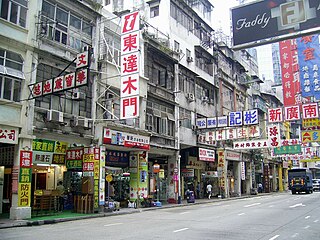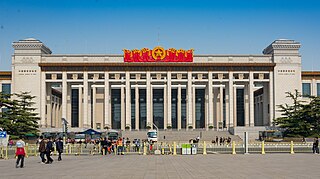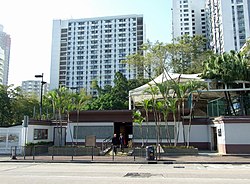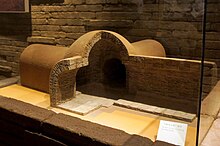
Hong Kong Island is an island in the southern part of Hong Kong. The island, known originally and on road signs simply as "Hong Kong", had a population of 1,289,500 and a population density of 16,390 per square kilometre (42,400/sq mi), as of 2008. The island had a population of about 3,000 inhabitants scattered in a dozen fishing villages when it was occupied by the United Kingdom in the First Opium War (1839–1842). In 1842, the island was formally ceded in perpetuity to the UK under the Treaty of Nanking and the City of Victoria was then established on the island by the British Force in honour of Queen Victoria. The Central area on the island is the historical, political and economic centre of Hong Kong. The northern coast of the island forms the southern shore of the Victoria Harbour, which is largely responsible for the development of Hong Kong due to its deep waters favoured by large trade ships.

The Hong Kong Museum of History is a public museum that preserves Hong Kong's historical and cultural heritage. It is located next to the Hong Kong Science Museum, in Tsim Sha Tsui East, Kowloon, Hong Kong.

Sham Shui Po is an area of Kowloon, Hong Kong, situated in the northwestern part of the Kowloon Peninsula, north of Tai Kok Tsui, east of Cheung Sha Wan and south of Shek Kip Mei (石硤尾). It is located in and is the namesake of the Sham Shui Po District.

The Kowloon Walled City Park is a park in Kowloon City, Kowloon, Hong Kong. The Kowloon Walled City had been a military stronghold since the 15th century due to its coastal location and was a slum. Under an agreement between the Government of Hong Kong and the People's Republic of China, the Kowloon Walled City was demolished in the 1990s. Some historic buildings and features were preserved for incorporation into the new park.

Yinxu is a Chinese archeological site corresponding to Yin, the final capital of the Shang dynasty. Located in present-day Anyang, Henan, Yin served as the capital during the Late Shang period which spanned the reigns of 12 Shang kings and saw the emergence of oracle bone script, the earliest known Chinese writing. The site's existence had been forgotten for millennia, along with that of oracle bone script and other material evidence of the Shang's existence. It was only rediscovered in 1899, following an investigation into oracle bones that were found being sold near the site. The rediscovery of Yinxu marked the beginning of decades of its intensive excavation and study. It is one of China's oldest and largest archeological sites, and was selected as a UNESCO World Heritage Site in 2006. Yinxu is located in northernmost Henan province near the modern city of Anyang, and near the Hebei and Shanxi province borders. Public access to the site is permitted.

The Hong Kong Museum of Coastal Defence is a public museum in Hong Kong, located in a former coastal defence fort overlooking the Lei Yue Mun channel, near Shau Kei Wan on Hong Kong Island. The fort was built by the British in 1887, intended to defend the eastern approaches to Victoria Harbour.
Declared monuments of Hong Kong are places, structures or buildings legally declared to receive the highest level of protection. In Hong Kong, declaring a monument requires consulting the Antiquities Advisory Board, the approval of the Chief Executive of Hong Kong as well as the publication of the notice on the Hong Kong Government Gazette.

The region of Hong Kong has been inhabited since the Old Stone Age, later becoming part of the Chinese Empire with its loose incorporation into the Qin dynasty. Starting out as a farming fishing village and salt production site, it became an important free port and eventually a major international financial center.

Tai Wai is an area in the New Territories, Hong Kong, located between Sha Tin and the Lion Rock, within the Sha Tin District.

The Leisure and Cultural Services Department (LCSD), is a department in the Government of Hong Kong. It reports to the Culture, Sports & Tourism Bureau, headed by the Secretary for Culture, Sports and Tourism. It provides leisure and cultural activities for the people of Hong Kong, which was also one of the tasks of the former Urban Council, and Regional Council and Home Affairs Bureau. It manages various public facilities around Hong Kong including public libraries, swimming pools, and sports centres. The well-known Hong Kong Cultural Centre and Hong Kong Space Museum are among several museums also managed by the department. It was established in 2000 and its headquarters is in Shatin, New Territories.

The architecture of Hong Kong features great emphasis on contemporary architecture, especially Modernism, Postmodernism, Functionalism, etc. Due to the lack of available land, few historical buildings remain in the urban areas of Hong Kong. Therefore, Hong Kong has become a centre for modern architecture as older buildings are cleared away to make space for newer, larger buildings. It has more buildings above 35m and more skyscrapers above 150m than any other city. Hong Kong's skyline is often considered to be the best in the world, with the mountains and Victoria Harbour complementing the skyscrapers.

The National Museum of China is the national museum of China. It flanks the eastern side of Tiananmen Square in Beijing, China. The National Museum of China has a total construction area of about 200,000 square meters, a collection of more than 1.4 million items, and 48 exhibition halls. It is the museum with the largest single building area in the world and the museum with the richest collection of Chinese cultural relics. It is a level-1 public welfare institution funded by the Ministry of Culture and Tourism.

Tonkin Street is a street between Sham Shui Po and Cheung Sha Wan of New Kowloon in Hong Kong. It runs northeast to southwest and crosses many major roads in the Cheung Sha Wan area. After extensive reclamation in West Kowloon during the 1990s, an extension Tonkin Street West (東京街西) was built.

Prehistoric Hong Kong is the period between the arrival of the first humans in Hong Kong and the start of recorded Chinese history during the Han dynasty. The history of the southern region is reckoned to have been first recorded in 214 BC with Qin Shi Huang conquering the Baiyue and creating the Jiaozhou province.

Law Uk is a former Hakka village house in Chai Wan, Hong Kong. Named after the surname of the family who lived in the house, it was built in the mid-18th century during the Qing Dynasty, about 90 years before the British took possession of Hong Kong Island. It was rediscovered in the 1970s and is a declared monument of Hong Kong. After being restored, the house was turned into the Law Uk Folk Museum, which serves as a branch of the Hong Kong Museum of History. It is the only example of Hakka architecture left in the area.

The History of Hong Kong under Imperial China began in 214 BC during the Qin dynasty. The territory remained largely unoccupied until the later years of the Qing dynasty when Imperial China ceded the region to Great Britain under the 1842 Treaty of Nanking, whereupon Hong Kong became a British Colony.

Lei Cheng Uk Estate is a public housing estate and Tenants Purchase Scheme estate in Lei Cheng Uk, downhill from Cheung Sha Wan, Kowloon, Hong Kong, located near the So Uk Estate. Since the redevelopment in 1980s, the estate consists of 10 residential buildings completed in 1984, 1989 and 1990 respectively. In 2002, some of the flats were sold to tenants through Tenants Purchase Scheme Phase 5. The estate is now managed by Hong Kong Housing Society.

The following is an overview of Public housing estates in Cheung Sha Wan, Hong Kong, including Home Ownership Scheme (HOS), Green Form Subsidised Home Ownership Scheme (GFSHOS), Private Sector Participation Scheme (PSPS), and Tenants Purchase Scheme (TPS) estates.
The Hong Kong Archaeological Society is a government-funded organization dedicated to carrying out excavations and preserving archaeological heritage in Hong Kong. The society is affiliated with the Hong Kong Museum of History to establish artifact collections and journal publications.
The visual art of Hong Kong, or Hong Kong art, refers to all forms of visual art in or associated with Hong Kong throughout its history and towards the present. The history of Hong Kong art is closely related to the broader history of Chinese art, alongside the art of Taiwan and Macau. Hong Kong art may include pottery and rock art from Hong Kong's prehistoric periods; calligraphy, Chinese ink painting, and pottery from its time under Imperial China; paintings from the New Ink Painting Movement and avant-garde art emerging during Hong Kong's colonial period; and the contemporary art practices in post-handover Hong Kong today.























